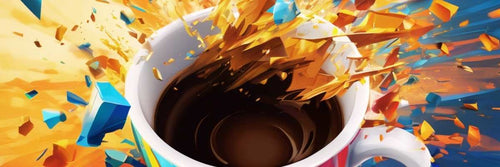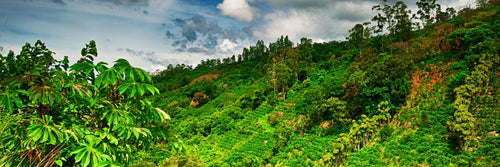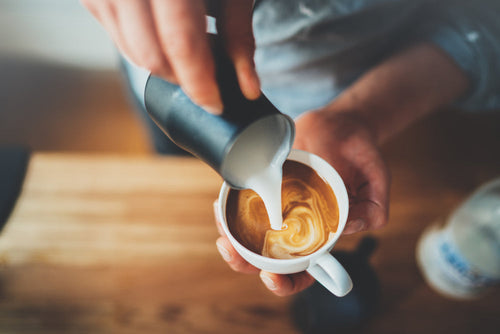
Espresso Beans vs Coffee Beans: What's the Difference?
By Jamie Cattanach
As a coffee professional, beans are your business. So chances are you already know the difference between espresso beans vs coffee beans all comes down to roast.
But to customers, it might not be so clear—and sometimes, it can be difficult to distill (or brew, if you will) your coffee knowledge down into something palatable to the everyday consumer.
So we put together this myth-busting article to help you and your customers distinguish between espresso beans and coffee beans. And, most importantly, prepare and enjoy the perfect drink, every single time.
Espresso beans vs coffee beans: It’s all in the roast, baby
Surprise (or not): There’s no such thing as “espresso beans.” There are, however, coffee beans that have been prepared in a way best suited to the espresso brew method. And even then, that’s a judgment made by the roaster; depending on your palate, you might actually like an “espresso” roast better as a drip or pour-over.
Still, roasters do have some level of consensus when it comes to what they call espresso. Espresso beans tend to be of a darker roast than beans prepared with other brew methods in mind. (And yes, this means that “dark roast” and “espresso roast” are basically interchangeable.)
That’s because darker roasts tend to impart characteristics that suit them well to the rigors of espresso—which, after all, isn’t really brewed so much as extracted, or expressed, under high heat and pressure.
Let’s take a closer look.
Espresso beans vs coffee beans: Roast level
True or false? The very same coffee bean could wind up as a blonde roast, middle-of-the-road medium-roast filter coffee, or espresso roast.

Coffee professionals know the answer is true, albeit with an asterisk: Certain roast levels will best bring forward the unique flavor profiles and nuances of beans of different origins and harvests. That’s where the art (and science) of roasting comes in, and that’s what makes each roaster’s products so unique and special.
Generally speaking, espresso roasts tend to be on the darker side, though espresso blends closer to a medium roast do exist. This is because the fast, high-pressure extraction method through which espresso comes to exist can amplify bitter and acidic tones in coffee—and lighter roasts tend to have more of those. Plus, the deep, sweet, chocolate-and-caramel flavor profile of a dark roast works delightfully when paired with milk, which espresso commonly is.
Espresso beans vs coffee beans: Roast method
Achieving the perfect espresso roast—or any dark roast, for that matter—isn’t as simple as just setting the timer for an extra few minutes on the heat.
In order to knock back any acidity and bitterness that might show up in a customer’s drink, beans destined to become espresso tend to be roasted low and slow, compared to, say, filter roast, which may see more heat, but for a shorter amount of time. That lengthier, gentler roast time helps to bring forward the dark, sweet, creamy notes that are espresso’s hallmark, not to mention building its round, full body. You can think of it a little bit like perfectly caramelizing onions: It’s not a process to be rushed.
Once the beans have reached the perfect level of darkness, roasters may work to cool them as quickly as possible, as excess time at temperature could reduce the level of sweetness in the cup.
Espresso beans vs coffee beans: Grind size
Once beans are roasted, the hardest part is arguably over—but they’re still not ready to be put to use. They need to be ground so that the water can pick up all that deliciousness during the brewing process. And when it comes to the main differences in espresso beans vs coffee beans, the grind is up there.

As you know, espresso is extracted from densely packed pucks of ground coffee, which helps create the dark, rich body and the smooth, milky crema these power-packed shots are known and loved for. In order for the process to work, espresso needs to be ground very finely to keep the pressure high as water is pressed through the well-compacted puck. (However, espresso grind isn’t the very finest; Turkish coffee is ground just a bit finer.)
Smaller coffee particles help make it possible for water to pick up flavor and body in the relatively short amount of time the brewing process takes. That’s why methods that take longer, like French press and cold brew, have coarser grinds—while coffee beans bound for drip or pour-over brewing are ground somewhere in the middle.
Can you use espresso beans to make other types of coffee?

The answer here is a simple one: Yes. When it comes to matching roasts to brew methods, you can frankly do whatever you want. Remember, the beans are the same; it’s the roast level and grind size that determine the best brewing method.
With that in mind, beans roasted dark enough to be considered espresso beans may not taste so great coming out of a pour-over or French press, since they may be missing some of the more bright, delicate aromas that we like to linger over with a larger cup of coffee.
The same holds true for using regular coffee beans for espresso: You can use them, but be aware that with their shorter roasting time, they won’t be as oily and so won’t produce much crema. They also won’t yield as deep and rich a flavor as espresso beans, making them a less than ideal candidate for high-pressure brewing methods.
That said, the world is truly your oyster in this regard. Experimenting with different beans and brew methods is one of the great joys of coffee, so there’s no reason to hold back. Seattle Coffee Gear's short video on the subject pretty much falls in line with our opinion.
Espresso Beans vs Coffee Beans: What About Coffee Bag Labels?
Here's one more helpful piece of information to pass along to your customers: When they see coffee bags in the store labeled "espresso" or "drip," you can advise them to approach those terms with a grain of salt. Those labels serve as recommendations from the roaster on the optimal brewing method to accentuate the beans' flavors. They're not strict rules.

It's also important to remember that coffee beans are versatile and adaptable to various brewing techniques. But again, "versatile" and "adaptable" may not mean "optimal"—just different. Still, we should encourage our customers to experiment and trust their own taste preferences rather than solely relying on these categorizations. Because as it's often said, "The best cup of coffee is the coffee you like."
Espresso Beans vs Coffee Beans: The Final Verdict
So now, you have a go-to way to summarize the espresso beans vs coffee beans debate to the next customer who broaches the topic: Espresso beans tend to be roasted darker and ground finer, and this is reflected in the taste. But, at the end of the day, coffee is coffee. It all depends on what the customer wants.
Editor's Note: Speaking of espresso, as of this early 2024 writing, we have an incredible espresso package featuring a Victoria Arduino 3-group Black Eagle Gravometric Espresso Machine, 2 Nuova Simonelli Mythos One expresso grinders, and the Nimbus/Kinetico S-Series 1400 including a filter array and 44 gallon tank! Owner purchased all of this new from Victoria Arduino in 2016 but never installed it. It is still in the original boxes and ready to be shipped today!







